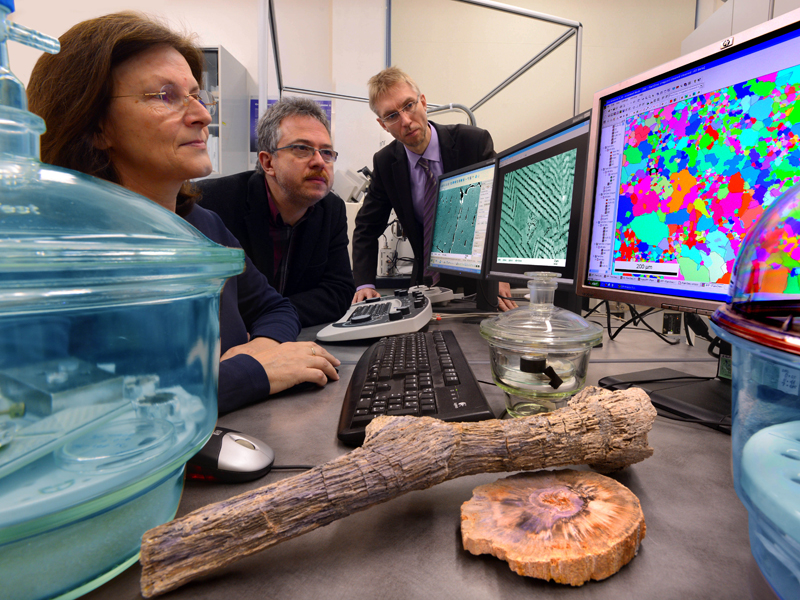291 million years back in time
Scientists of the Surface Technology/Functional Materials Group of TU Chemnitz enter deeper than ever before into the finds of the Petrified Forest of Chemnitz by using electron microscopes
-

Dr. Dagmar Dietrich und Prof. Dr. Thomas Lampke (behind) of the Surface Technology/Functional Materials Group und Dr. Ronny Rößler, Director of the Museum of Natural History, enter deeper than ever before into the finds of the Petrified Forest of Chemnitz by using electron microscopes. Photo: Wolfgang Thieme
For millions of years, the soil of the city of Chemnitz has concealed a precious treasure, i.e. an ancient world of plants and animals which was encased in ashes after a volcanic eruption in the Permian and which has converted into stone through the centuries. The mighty fossil woods were first discovered in 1737 during digging works in Hilbersdorf, which is now a district of Chemnitz. Later, Mr. Güldner, who was the constructor of the diggings, donated several of his fossilized logs to the King Albert Museum in Chemnitz. Most of those logs are now being exhibited in the Museum of Natural History at the TIETZ. The `Petrified Forest of Chemnitz´ is the largest and heaviest plant fossil in Europe and one of the most outstanding natural monuments in the world.
Scientific ambition and the hope for discovering further ancient remains of the Petrified Forest have led to regular digging activities in Chemnitz. Scientific excavations at the Frankenberger Straße which started more than five years ago under the direction of the Museum of Natural History, indicate that the existence of further fossils from the tropical rainforest is very likely. From 2008 to 2011, approximately 630 fossils of trunks and branches as well as 1,200 plant and animal imprints, including the first scorpions from the Permian, were discovered. The enormous amount of attention placed on the Petrified Forest of Chemnitz from all kinds of international scientists has been an overwhelming experience. Large research funders such as the Volkswagen Foundation have accompanied and supported the initial research of the spectacular finds. As a result of the `Window into the History of Earth´, which is funded by the European Union, the excavation tent has been relocated to the Glockenstraße in May 2013. For the next ten years, 200 square meters of volcanic rock formations are supposed to be excavated up to three meters depth, documented and analyzed for traces of life.
The researchers of the Surface Technology/Functional Materials Group of Technische Universität Chemnitz have supported this treasure hunt for many years. "The investigation of the microstructure of the samples of fossil wood with the help of our scanning electron microscope, which allows up to 100,000-fold magnifications and additional studies on the chemical composition and crystalline structure, contributes to the understanding of the process of fossilization of the organic components of plants", reports Prof. Dr. Thomas Lampke, Chair of the Surface Technology/Functional Materials Group. So, cut samples of a tree fern and two gymnosperms, namely Cordaites and Medullosales, were examined. "Illustrations and diffractometry with backscattered electrons show the excellent anatomical preservation of the plant tissue caused by mineralization," explains Dr. Ronny Rößler, Director of the Museum of Natural History. "We see, for instance, the penetration of the silicic acid and where and how the silica has formed crystallites. Obviously, a directed crystal growth ensued on the cellulose of the former cell walls. Thus, the Chemnitz fossils are a very early model of the formation of ceramic materials on biopolymer templates," adds Dr. Dagmar Dietrich, laboratory assistant of the Surface Technology/Functional Materials Group. Dietrich, Lampke and Rößler published their recent scientific studies at the end of 2013 in a multi-page article in a German journal of the Springer Verlag called `Paläontologische Zeitschrift´. "We had so much feedback from the scientific world - a researcher from New Zealand might even be interested in a joint research project," says Dietrich. To understand the process of fossilization has been an objective that researchers around the whole world have aimed to achieve since the Middle Ages.
"The joint investigation of TU Chemnitz and the Museum of Natural History is now pushing us another step forward," the director of the museum says proudly. Therefore, it is particularly important to him and a fortunate coincidence that he can work together with motivated and highly qualified researchers in the fields of Materials Science, Chemistry and other interdisciplinary fields at TU Chemnitz. "During the excavations, for example, electrical engineers of Technische Universität Chemnitz supported us with their 3D scanners to explore the grounds," says Rößler.
Anyone interested in the unique scientific finds as well as in gaining further information on the excavation sites is warmly invited to visit the Museum of Natural History in the heart of the city. On the first floor of the TIETZ, which has preserved one of the oldest and most complete terrestrial ecosystems from the Permian for posterity, it is possible to again witness the volcanic eruption of the Beutenberg in the Zeisigwald in an audiovisual way. In 2006, the city of Chemnitz proposed a motion for the acceptance of its claim to put the Petrified Forest on the UNESCO`s list as a world heritage site - the Saxon Cabinet has not yet supported this request. However, this refusal does not discourage the researchers at Technische Universität and at the Museum of Natural History: "We are going to continue looking into the question of how the silicic acid could reach millions of years ago into the cells of plants without destroying them," says Rößler.
Contact information of the Surface Technology/Functional Materials Group: Prof. Dr. Thomas Lampke and Dr. Dagmar Dietrich, Tel: +49 (0) 371 531-35392, E-Mail dagmar.dietrich@mb.tu-chemnitz.de, Website: http://www.tu-chemnitz.de/mb/OTF/index_en.php
A video contribution on the joint research of the Museum of Natural History and TU Chemnitz is available on YouTube (in German).
For further information please visit the following website: http://www.naturkunde-chemnitz.de/?pg=home&id=natur_eng&language=eng
The Chemnitz excavation sites as well as the Petrified Forest were also part of an elaborately produced film documentation of the Science Magazine `Terra X´ on ZDF (in German).
(Author: Mario Steinebach, Translation: Vanessa Drexler, Jakob Landwehr)
Mario Steinebach
21.01.2014




